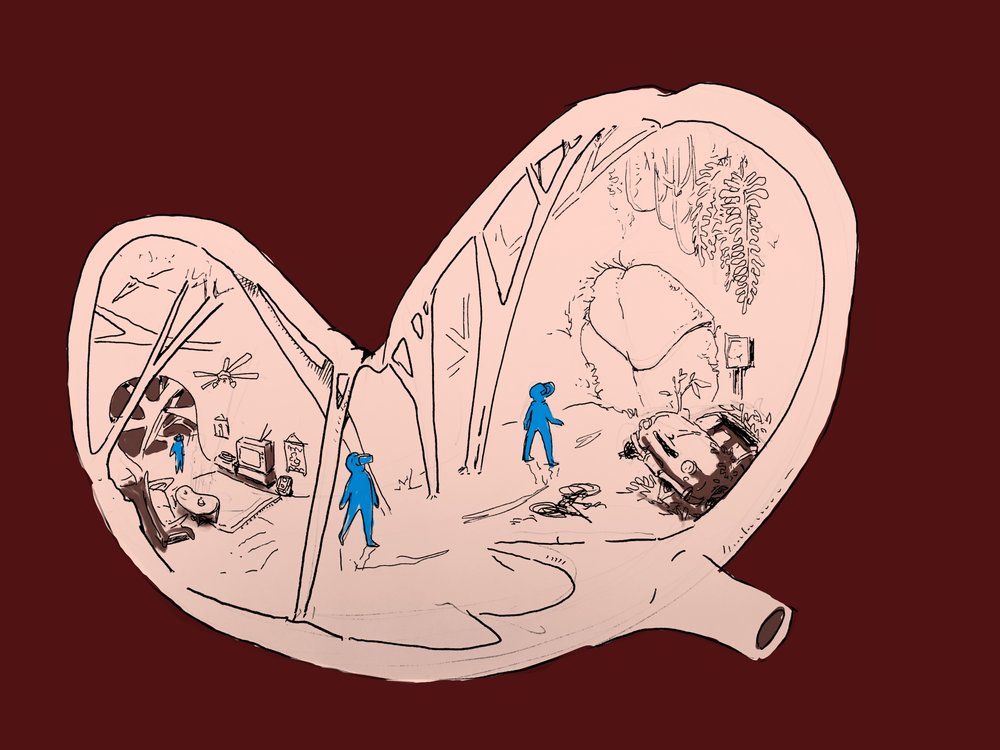Stay Alive My Son
Creating the early steps of a powerful VR experience that chronicles the harrowing true story of a father searching for his lost child during the Khmer regime.

One of my early concept arts illustrates the idea of a heart full of memories. The participant would embody the owner of the heart as both try to make sense of the tragic, real life, ordeals that unfold.

Ideation
The creative process was highly iterative, focusing on rapid prototyping of concepts together with the director. For this we had to explore several different visualizations and storyboarding tools, often having to expand them to comply with the needs of Virtual Reality.

WHO ARE YOU?
When creating an immersive narrative, the first question I posted was, “who is the viewer (or participant)?” Unlike most traditional media, there are no walls separating the viewer from the story being told around they. Usually, the first thing immersive media viewers do when wearing a headset is to look at their hands and body – even if there are none, in order to “anchor” their self in this new environment.
Being a biographical story, the straightforward approach would be to tell the story through the main character’s eyes and let the participant just agree to this. But we decided to play with the ambiguity of viewer/participant presence and deliberately invite they to step in and out of the main character’s point of view. Even the world where the story happens would be an extension of the main character’s body – his heart and memories as a place to be explored by the participant and himself.
I was really excited about the opportunity to turn embodiment into the core narrative mechanic and not just a problem to be solved.
Sketching for Immersive Interaction Design
I created hundreds of sketches in order to explore novel narrative mechanics powered by unique interactions that are exclusive to immersive technologies like VR. One of the greatest challenges of the medium is how to depict experiences that are only truly possible inside the virtual environment before any actual programming has happened. For this, detailed storyboarding is crucial. Quickly putting together an animated animatic was a powerful tool for the production team.
World Building
Quick sketches that demonstrate the basic concept behind the environment design. The journey takes place inside the main character’s heart – both literally and figuratively. I wanted to try something different from the traditional dreamscapes, normally associated with flashbacks. The pain these memories bring are real, so for me, it was important to show the gross physicality of his suffering by always having some anatomical element of the heart as an environmental feature.
Concept Art
Quick sketches that demonstrate the basic concept behind the environment design. The journey takes place inside the main character’s heart – both literally and figuratively. I wanted to try something different from the traditional dreamscapes, normally associated with flashbacks. The pain these memories bring are real, so for me, it was important to show the gross physicality of his suffering by always having some anatomical element of the heart as an environmental feature.
SHOOTING 360 WITH PROFESSIONAL ACTORS.
To further understand character development and dialogue in VR, we were joined by Chris Hall, an award-winning producer of 360 VR experiences. We used real actors to act out the scenes around a 360 Ricoh Theta camera. The insights generated were used to create the motion script and to find out the best way to direct the participant’s attention. It was also a lot of fun to see professionals actors adding real emotional depth to scenes I’ve been working on for days.





Final Version
After the prototyping phase, the production moved to different studios and the project kept evolving until it was released on the global festival circuit where it is winning critical praise at Venice, Sundance, and Tribeca.
THANK YOU TO ALL INVOLVED IN PROTOTYPING THIS AMAZING PROJECT
Victoria Bousis – Director
Nicolás Escarpentier
Todd Bryant and the R-Lab NYC
Misha Zabranska
Mathew Niederhauser and John Fitzgerald – Sensorium
Chris Hall
All of the studios, professionals and friends who opened their doors and offered their insights and support